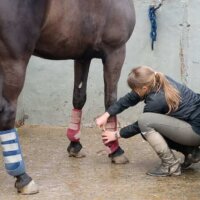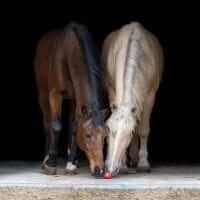Equine Articles
A tendon and ligament injury is common in the equine industry, impacting upwards of 30% of horses. Despite the injuries being common, most often result […]
Read MoreEquine health and soundness is critical for the competition athlete. It is something that many struggle with during the competitive season, which then often translates […]
Read MoreJoint injections are all too common in today’s equine world and one of the main reasons why I opted to go to the opposite side and seek alternative options, as a veterinarian. The most common reason for their use is joint disease, mainly arthritis, with the intent or purpose to alleviate pain and prolong or improve performance. In many, their use is warranted while in others, not so much. In either case, if we do decide to go that route, with an injection, we need to understand the pros, the cons and what options are before us to help extend the effects of those injections. After all, they are not cheap and do not come without harm.
Read MoreThe performance of an equine athlete is vitally important whether if we are talking Dressage, Jumping, Western Pleasure, Barrel Racing or on track TB or QH racing. One of the biggest determinants of performance is stamina. Without stamina, almost always, performance is reduced on various levels. So, what determines one or the other? What dictates performance in that equine athlete and considering that stamina is involved, what options do we have to improve the outcome?
Read MoreItching, scratching, coughing, red eyes, hair loss and oozing skin bumps….all related to allergic conditions in the horse and a common occurrence. Current approaches to therapy are often complex and unrewarding, leading to the allergic condition often becoming worse with every passing year, fluctuating from season to season. All of these clinical signs are evidence of a deeper seated problem in the patient, and through a better understanding, we can take a different approach which often yields better management. As with most issues though, in regards to chronic disease, we have to see the root, the cause, and not so much focus on the clinical signs that are present.
Read MoreEIPH or exercise induced pulmonary hemorrhage is unfortunately a common condition in equine athletes, affecting upwards of 40% of race horses and an estimated 62% of QH’s involved in racing, including other disciplines such as barrel racing.2 It is one of the main causes of decreased performance and also one of the more common respiratory problems found in competitive equine athletes, especially when involving epistaxis or nasal bleeding. EIPH can be very frustrating for some trainers, due to the fact that a specific cause in each case is often not determined and response to therapies can decrease over time. In many instances, the equine athletes are able to maintain higher levels of performance, while other are forced to retire. As with many equine health conditions, with a better understanding, sometimes we can implement therapy options to improve the outcomes, helping to keep performance to a high level.
Read MoreNutrition is vital to health, impacting the immune response, muscle and tendon health, hoof, skin and even vision. It is critical to almost every facet and function of the body, including energy production, which is at the root source. As important as it is, nutrition is not always easy to achieve as forage sources can vary from season to season and demands by the body can equally fluctuate. Many horse owners rely on supplemental vitamin/mineral products which are actually synthetic nutrient derivatives, which do not provide the same value as those obtained from real food. Our horses want and demand better!
Read MoreA healthy immune response is critical to health for our equine companions on many levels. An increased incidence of infection from bacterial to viruses are more common in those horses under high stress loads or poor nutritional planes, due to reduced function and health of the immune response. However, the immune response is involved not just in infections, but overall health, healing, digestive function and even the process of inflammation. Boosting and supporting the immune response to benefit the entire body has never been more complete, until now!
Read MoreUlcers and hindgut problems are rampant in the equine community, resulting in high use of medications and dramatically impacting performance. Most owner continue to battle these problems on a daily basis with little results gained, even with high use of costly medications. In many instances, we are literally chasing our own tails, as even with these therapies, we are not addressing the main problem. Are there better options available?
Read MoreCur-OST EQ Green; General Support & Prevention with a Boost
Inflammation is one of the biggest contributors to overall poor health and lameness, including joint and tendon related problems. Prevention is one of the keys to controlling problems down the road in the performance horse. If we can control the issues and the process, we can maximize gains hopefully with little issues in the near future. Ideally, our goal is to balance inflammation and provide nutrients to benefit the entire body.
Read MoreJoint degeneration, tendon injuries, laminitis, navicular conditions and even back pain can limit any horse, but especially those competitive athletes. In many cases, these conditions have progressed further than we would like, resulting in marked changes to the joints and even damage to tendons or ligaments, often becoming unresponsive to traditional therapies and medications. The bottom line contributor is the inflammatory process, which impacts cell health, circulation, cell function and overall health. Sometimes, those patients require a higher level of support to ease their discomfort and improve overall performance in what ever they do.
Read MoreJoint problems, back problems and tendon/ligament issues are quite common in the performance horse. The countless problems often lead to high expense in regards to maintenance through injections, medications and other remedies, more often than not leaving the owner desiring more for their companion. All of these problems are part of the business and secondary to stress forces put upon the body on a cellular level. The bottom line contributor is the inflammatory process and if that process can be controlled or better managed, the outcome will be markedly enhanced, not only improving the health and performance of that athlete, but also improving the bottom financial outlay.
Read MoreAnxiety is a common problem in the equine industry, often connected right back to stress on a physical and emotional level. There are many contributors to the anxiety, ranging from diet to training, including natural personality tendencies in some breed of horses. Anxiety and stress contribute to a host of health problems in the horse and even impact performance, leading to many owners struggling to find solutions.
Read MoreStamina and performance are two key issues on the competitive horse owner’s minds. Those two factors can make all of the difference and separate your horse out from the others in any competition, whether if it is barrel racing, flat racing, dressage or jumping. There are many contributors to enhancing stamina and performance, some of which are inherent in that horse, but others can be manipulated to enhance results! It’s not really about “Performance Enhancement” but more so about “Health Restoration“. If we restore health and cell function, then performance and stamina soon follow.
Read MoreInflammation is rampant in the equine patient, impacting joints, allergies and even gut health. Solutions are endless, but can often result in owners utilizing multiple products, often without results. The Cur-OST® EQ Total Support may be the answer you are seeking, providing a solution in a single product, impacting joints, allergies, gut concerns and even eye complaints!
Read MoreThe equine foot is one of the most common sources of lameness, often contributing up to 80% in most cases. Many times, the pain originates in the foot then transfering up the limb to create secondary lameness concerns. Three of the most common sources of frustration and lameness in the foot are abscesses, bruises and thrush, not excluding white line disease. They are very common but continue to plague many horses on a daily basis, proving difficult to remedy at times. As with most cases, with a better understanding of the conditions, we stand a better chance of success in regards to management.
Read MoreNavicular syndrome is a very common problem in the equine industry, likely impacting 30% or more of horses, dependent on the breed and discipline. We see this condition commonly in the western disciplines but also to varying degrees in other sports, including jumping, dressage and even racing. There are many factors that contribute to the problem, which can make it difficult at times to manage. All too often, though, we tend to wait until the condition has progressed, with irreversible damage, before we properly intervene. With a better understanding, hopefully we can recognize the condition sooner, see contributing factors and produce better results for the patient in the long term.
Read MoreThe equine athlete and non-athlete are often plagued with coughing, which can inhibit quality of life and reduce performance. Coughing can be sporadic, changing in intensity as the environment changes or it can be continuous, becoming worse or more prominent at the time of exertion as seen during competition. Some coughs even get worse with certain seasons, becoming progressive over time. So, what makes them cough and what can we do about it?
Read MoreThis is likely one of the most common questions on most horse owner’s minds. How can I reduce costs, but yet still maintain the level of health or soundness in my equine companion? It is a good question, but unfortunately one that is easier to answer in some horses compared to others. The bottom line is that there are options, but in many cases, we have to define what the problems are and target the sources. It is possible and likely more readily achieved than most realize.
Read MoreAnhidrosis is a common problem, impacting upwards of 10% of horses, usually subjected to high heat and humidity for prolonged periods of time. It is an important condition, as its presence can impact stamina, recovery and overall ability by the owner to exercise their horse. Sweat production is vital for the body, not only to aid in detoxication, but also in thermoregulation, so when the horse cannot sweat, they can quickly overheat. Solutions are sporadic, with some of these therapies helping a few horses, while others do not benefit. Hopefully, if we take a deeper look into this condition, we can arrive at some potential options to improve management.
Read MoreStress; The Battery of Life and Impact on Health, Fatigue and Recovery
Stress is something that we all encounter daily whether if we are animal or human. Stressors are the reason as to why we adapt and hopefully overcome new challenges, whether if that is a new task at work, a new exercise routine or environmental changes. It is what hopefully makes us stronger, more resilient. Those stressors create a stress response in our body, which then we hopefully adapt to over time. The question is how much stress is our body supposed to handle, or that body of our equine companions or even pets, and how does prolonged stressor exposure impact health, recovery and even soundness or injury?
Read MoreSelenium and vitamin E are often two of the most common supplemented antioxidants in horses, often attributed to poor soil conditions and likewise perceived deficiencies in the patient. They are both important antioxidants and vital to cellular health, but all too often, we just supplement without justification or even more, we fail to see rationale for the need for supplementation. Each horse is different and just because a region is perceived as deficient in selenium or a forage is low in vitamin E, does not always equate to the need for supplementation in every horse. We need to look deeper, connect the dots and seek deeper, underlying problems which may be addressed adequately.
Read MoreCurcumin is one of the most heavily researched herbs due to its potential to impact the inflammatory process in several models. One key concern, in some studies, is bioavailability or absorption, which has likewise raised concerns as to its true efficacy in regards to health conditions. Are these concerns truly founded or is it all hype? Experience tells us that it is a little of both.
Read More




























